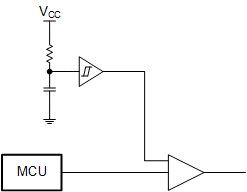I am using an FTDI FT230XQ chip connected to an upstream USB port to provide Rx and Tx communications in order to program/reprogram my custom portable device from the USB port. I also use the USB connection to provide battery charging current to the device. I use a handy USB programming utility that offers a feature to commence programming when it detects that the target micro has powered up. However, the FT230 Tx output defaults to active high when connected to an upstream USB port which, in turn, powers up the target microprocessor through the micro's input pin and parasitic diode. When it does this, the micro does not power-up reset properly and hence does not issue its "power start up" bit to the programming utility, and programming fails. If I disconnect the FT230 Tx line from the target device, and allow its own power supply to bring it up, then connect the Tx line again after initiating the utility, before the utility times out, I get a successful programming event.
So it seems that what I need is a buffer for the FT230 Tx line that produces a high-impedance to the micro until the micro's own power supply brings it up properly, then when that happens, allows the FT230 Tx signals to pass through to the micro Rx input. Can you suggest such a device? Any possibility that an SN74LV1T34 might work? Here I would power the T34 from the micro's Vcc (3.3V) and not USB power. Once powered up from the micro's power supply, the T34 might then successfully pass through Tx line toggling. But I don't know what the input load is when the device is not powered up, what the output impedance is when not powered up, or what its behavior is when input signal is toggling when power is not applied. We use those elsewhere in the product for level shifting between 5V logic and 3.3V.


